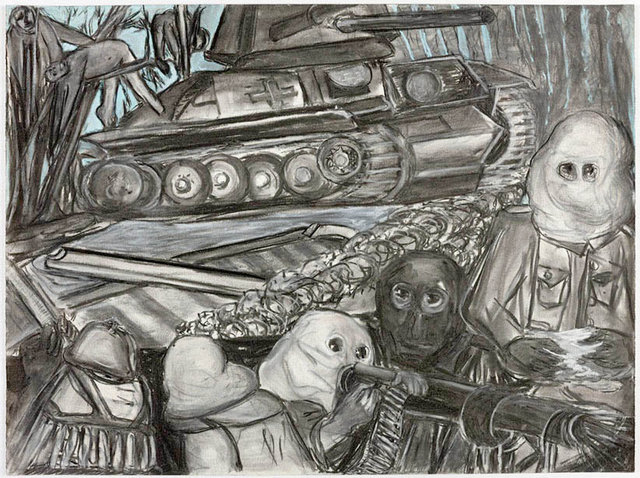Jacqueline de Jong
WAR: The imminent conflict (again) - 03 May - 13 June 2014
Pastel on paper 40 x 70 cm Foto: Gert Jan van Rooij Jacqueline de Jong (b.1939) has never been shy of depicting difficult subject matter in her art: violence, death, eroticism, crime and conflict (we see these subjects usually through the eyes of male artists). De Jong was both a young survivor of WWII, and a witness to turmoil and violence in May '68 in Paris, where she joined the radical avant-garde movement: Situationist International. In 1991 she felt compelled to address the Iraqi Gulf War, depicting its horror in a series of powerful canvases which caused quite a sensation at the Amsterdam Art Fair that year. For an activist artist there is always the challenge to renew and experiment, to take a standpoint, to send a message. And so de Jong's current work conveys her outrage anew at the use of gas as a weapon in war. First used in WW1, then outlawed for decades, returning in WWII, then recurring again in the Gulf War and the Syrian civil war. Against a backdrop of apocalyptic visions of chaos, devastation and marauding tanks, we see figures in camouflage, human and equine faces alike obscured by gas masks and protective goggles. On the battlefields or in the trenches we see decomposing and dismembered bodies of soldiers, or veiled women in mourning. De Jong shows us the harsh and ruthless brutality of a faceless war, in her own particular style and figuration. Her colours are both subdued and incongruous; her landscapes bursting with intense reds, greens and purples all an assault on the sensitivities of the viewer, who cannot but be moved. At 75, de Jong remains in constant motion: adventurous, opinionated, controversial and cosmopolitan. Her work is represented in major museums and private collections and she has recently exhibited in New York, Paris, Stockholm and Karlsruhe and in museums in Oslo, Durbach, and Copenhagen.

